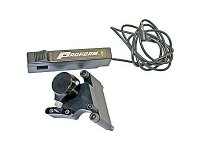what you add to what depends on what the marks are referencing. the only time you'd add anything together is if the marks were not on zero...
what works best is to put clear visible lines using "white out" or a white (or yellow) paint pen on both marks. some pointers have the degree #'s and some balancers or pulleys do, but the important part is to mark 0 degrees and the indicator(usually TDC) line. Often time these marks are not easily visible or clear. Using a timing light like the one you are refering to allows you to simlify things and just use a single clear mark on each surface. when these line up, the timing is whatever the dial says.
exact procedures for testing will depend on the application. REMEMBER: in most cases the vaccum or computer advance mechanism will need to be disabled... also base timing is easily checked at idle, while total timing will be checked at a higher RPM usually atleast 3000 but often over 4000.
the craftsman light that has the dial is the "profesional" one and runs around 70 or 80 bucks i believe.
initial timing can also very important, but slighly less so for racecars. it has a large bearing on vaccuum output at idle, the smoothness and quality of the idle, as well as the engine's ability to (re)start hot. the last bit, of course, is very important...
 . How do the "adjustable" units work. Can you dial in how much timing you want and when set correctly the TDC mark on the pulley will line up with the pointer?
. How do the "adjustable" units work. Can you dial in how much timing you want and when set correctly the TDC mark on the pulley will line up with the pointer?
